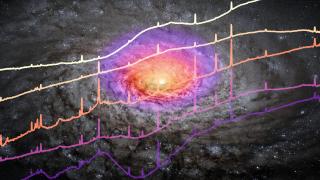Bibcode
Font, J.; Beckman, J. E.; Martínez-Valpuesta, I.; Borlaff, A. S.; James, P. A.; Díaz-García, S.; García-Lorenzo, B.; Camps-Fariña, A.; Gutiérrez, L.; Amram, P.
Referencia bibliográfica
The Astrophysical Journal, Volume 835, Issue 2, article id. 279, 21 pp. (2017).
Fecha de publicación:
2
2017
Revista
Número de citas
45
Número de citas referidas
41
Descripción
We have used Spitzer images of a sample of 68 barred spiral galaxies in
the local universe to make systematic measurements of bar length and bar
strength. We combine these with precise determinations of the corotation
radii associated with the bars, taken from our previous study, which
used the phase change from radial inflow to radial outflow of gas at
corotation, based on high-resolution two-dimensional velocity fields in
Hα taken with a Fabry–Pérot spectrometer. After
presenting the histograms of the derived bar parameters, we study their
dependence on the galaxy morphological type and on the total stellar
mass of the host galaxy, and then produce a set of parametric plots.
These include the bar pattern speed versus bar length, the pattern speed
normalized with the characteristic pattern speed of the outer disk
versus the bar strength, and the normalized pattern speed versus { R },
the ratio of corotation radius to bar length. To provide guidelines for
our interpretation, we used recently published simulations, including
disk and dark matter halo components. Our most striking conclusion is
that bars with values of { R } < 1.4, previously considered
dynamically fast rotators, can be among the slowest rotators both in
absolute terms and when their pattern speeds are normalized. The
simulations confirm that this is because as the bars are braked, they
can grow longer more quickly than the outward drift of the corotation
radius. We conclude that dark matter halos have indeed slowed down the
rotation of bars on Gyr timescales.
Proyectos relacionados

Estudios Cinemáticos, Estructurales y de Composición, de los Medios Interestelares e Intergalácticos
El objetivo básico del proyecto es investigar la evolución de las galaxias mediante el entendimiento de la interacción del medio interestelar y las estrellas. La técnica principal que utilizamos es la cinemática bidimensional de galaxias enteras observada por nuestro instrumento GHaFaS, un interferometro Fabry Perot en el telescopio William
Prof.
John E. Beckman

Actividad Nuclear en Galaxias: una Perspectiva 3D del Núcleo y su Entorno
Nuestro proyecto puede dividirse en dos líneas principales de investigación. En primer lugar, el estudio de los vientos producidos por cuásares luminosos oscurecidos y del impacto que estos tienen en sus galaxias anfitrionas (retroalimentación del AGN). Para ello hemos obtenido observaciones en el óptico e infrarrojo cercano con el Gran Telescopio
Cristina
Ramos Almeida